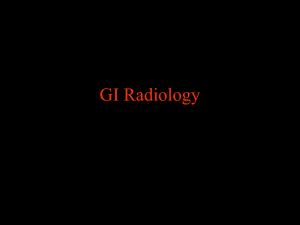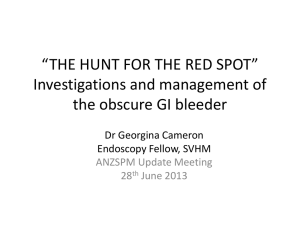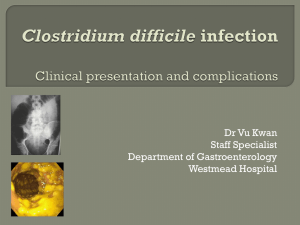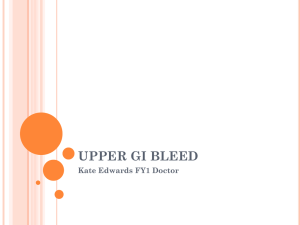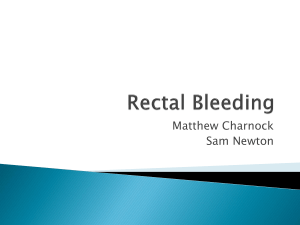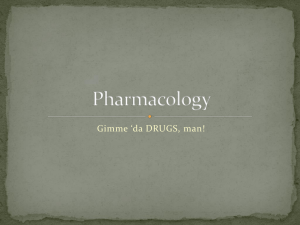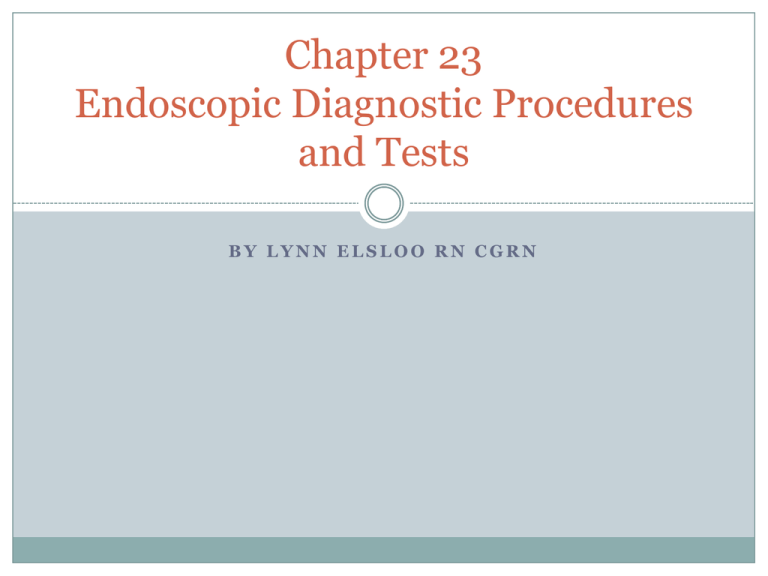
Chapter 23
Endoscopic Diagnostic Procedures
and Tests
BY LYNN ELSLOO RN CGRN
Objectives
Describe the different types of endoscopes and
their components.
2. Discuss the indications for EGD, ERCP,
enteroscope and colonoscopy.
1.
GI Endoscopy is defined as the direct visual
examination of the lumen of the gastrointestinal
tract.
Endoscopes
1.
2.
3.
4.
5.
A flexible end-viewing or side-view endoscope
An anoscope
A proctosigmoidoscope or rectosigmoidoscope
A flexible sigmoidoscope
A colonoscope
Sedation and Analgesia
4 levels of continuum of sedation depth
Minimal sedation
Moderate sedation/analgesia
Deep sedation/analgesia
General anesthesia
Sedation
In the endoscopy setting, moderate
sedation/analgesia is most often induced by IV
benzodiazepines (Versed & /or Valium) and
narcotics (Demerol, Morphine, Fentanyl)
Goal of moderate sedation includes the following:
1) Maintain intact protective reflexes
2) Allow relaxation to allay anxiety and fear
3) Minimize changes in vital signs
4) Diminished verbal communication
Sedation
5) Ensure cooperation
6) Decrease pain perception
7) Ensure easy arousal from sleep
8) Maintain patient ability to respond to commands
9) Provide some degree to retrograde amnesia
Monitoring
Observe and document patient’s response to
medications and the procedure.
i.e.: oxygen saturation, blood pressure, respiratory
rate and effort, EKG, level of consciousness, warmth
and dryness of skin, pain tolerance, abdominal
distention
Notify physician of any changes and be prepared to
intervene in event of complications
Esophagogastroduodenoscopy (EGD)
Indications:
dysphagia or odynophagia
Dyspepsia
Anemia
Esophageal reflux – persistent despite therapy
Persistent, unexplained vomiting
Upper GI x-rays showing lesions that require biopsy
Esophagogastroduodenoscopy
More Indications:
Suspected esophageal or gastric varices
Suspected esophageal stenosis, esophagitis, hiatal
hernia, gastritis, obstructive lesions and gastric or
peptic ulcers
Epigastric or chest pain
Chronic abdominal pain
Suspected polyps or cancer
Esophagogastroduodenoscopy
More Indications:
Follow-up of patients with Barrett’s
esophagus, ulcers, or previous gastric or
duodenal surgery
Removal of ingested foreign bodies
Caustic ingestion
Oral aversion
In conjunction with dilation of the upper GI
tract
Esophagogastroduodenoscopy
More Indications:
Placement of a feeding tube or removal of one
Esophageal prosthesis placement
Pre-surgical screening
EGD
Contraindications:
Suspected perforated viscus
Shock
Seizures
Recent M.I.
Severe cardiac decompensation
Thoracic aortic aneurysm
Respiratory compromise
EGD
Contraindications (continued)
Severe cervical arthritis
Acute oral or oropharyngeal inflammation
Acute abdomen
Known Zenker’s diverticulum
Uncooperative patient
Noncompliance with NPO guidelines
EGD
Possible adverse reactions:
Respiratory depression or arrest
Perforation of the esophagus, stomach or duodenum
Hemorrhage related to trauma or perforation
Pulmonary aspiration or blood, secretions or
regurgitated gastric contents
infection
EGD
More possible Adverse Reactions:
Cardiac arrhythmia or arrest
Hypotension
Localized phlebitis related to IV diazepam
Vasovagal response
Allergic reaction to the IV medications
Endoscopic Retrograde
Cholangiopancreatography (ERCP)
Indications:
Evaluation of signs or symptoms suggesting
pancreatic malignancy when results or
ultrasonography and/or CT scan is normal or
equivocal
Evaluation of acute, recurrent or chronic pancreatitis
of unknown etiology
Before therapeutic endoscopy of the biliary tree
ERCP
More Indications:
Unexplained chronic abdominal pain of suspected
biliary or pancreatic origin
Evaluation of jaundiced patients suspected of having
treatable biliary obstruction
Evaluation of patients whose clinical presentation
suggests bile duct disease
Pre-op or post-op evaluation to detect CBD stones in
patients who undergo lap chole
Manometric evaluation of the ampulla and CBD
ERCP
Contraindications:
Uncooperative patients
Recent M.I.
Severe pulmonary disease
Coagulopathy
Pregnancy
Pancreatitis (depending on clinical situation)
ERCP
Possible Adverse Reactions:
Pancreatitis
Biliary Sepsis
Aspiration
Bleeding
Perforation
Respiratory depression or arrest
Cardiac arrhythmia or arrest
ERCP
Nurse should observe for and report:
Rise in temperature/low-grade fever
Chills
Nausea and/or vomiting
Abdominal pain or distention
Tachycardia
Small Bowel Enteroscopy (SBE)
Indications:
GI bleeding of suspected small bowel origin, with
continued or intermittent blood loss, in whom a GI
bleeding site has not been found despite testing.
For patients with SB abnormality out of reach with a
standard scope.
Contraindications are the same as
for EGD.
SBE
A small bowel enteroscope (250 cm in length) is
passed through the esophagus, stomach and small
intestine for its full length.
Sonde or Peristalsis method uses a pediatric
colonoscope as a push enteroscope to advance a long,
thin, flexible Sonde enteroscope into the small
bowel.
Balloon enteroscopy
SBE
Complications include: perforation, pancreatitis
and gastric mucosal stripping.
Patients must be observed post procedure for
significant abdominal distention due to the length of
the procedure and amount of air insufflation.
Colonoscopy
Indications:
•
•
Evaluation of active or occult lower GI
bleeding, such as hematochezia, melena
with a negative upper GI investigation,
unexplained fecal occult blood and
unexplained iron-deficiency anemia
Evaluation of abnormalities found on
radiographic examination
Colonoscopy
More Indications:
•
•
•
Suspected cecal or ascending colonic
disease
Surveillance for colon neoplasia in patients
who have had a previous colon cancer or
previous colon polyps
Screening in patients 50 years of age or
older, in patients with a personal history of
polyps or colorectal cancer
Colonoscopy
More Indications:
•
•
•
•
•
And in patients with a first-degree (parent or sibling) family
history of colon cancer
Surveillance in patients with chronic ulcerative colitis (UC) of
several years’ duration
Diagnosis of management of chronic inflammatory bowel
disease
Chronic, unexplained abdominal pain
Confirmation of suspected polyps, rectal or colonic strictures
or cancer
Colonoscopy
Contraindications:
Fulminant ulcerative colitis
Acute radiation colitis
Suspected toxic megacolon
Suspected perforation
Acute, severe diverticulitis
Presence of barium
Imperforate anus
Colonoscopy
Contraindications:
Massive
Colonic Bleeding
Shock
Acute
surgical abdomen or a fresh surgical
anastomosis
Colonoscopy
The objective is to reach the cecum as quickly and
safely as possible then to meticulously inspect the
colon during withdrawal. This is the time to perform
therapeutic procedures such as polypectomy,
dilatation, biopsy, etc.
Major complications occur in less than 1% of patients
undergoing colonoscopy.
The 2 most common complications, perforation
and hemorrhage, most likely occur during or after
polypectomy.
Colonoscopy
Other complications from colonoscopy include:
medication reactions - cardiac arrhythmias or arrest,
respiratory depression or arrest.
explosion of colonic gases
vasovagal reactions
cardiac failure or hypotension r/t prep
biopsy site bleeding is rare unless pt has
coagulation issues or on blood thinning
products.
Anoscopy
Indications:
Hemorrhoids and fissures (the most common cause
of bright red rectal bleeding in adults)
Position:
Sims’ left lateral or knee-chest position
or special proctologist tilt table to invert pt.
Proctosigmoidoscopy, a.k.a.
Rectosigmoidoscopy
Indications:
•
•
•
•
•
•
Melena or bleeding from the anorectal area
Persistent diarrhea
Change in bowel habits
Passage of pus or mucus
Suspected chronic inflammatory bowel
disease
Bacteriology and histological studies
Proctosigmoidoscopy, a.k.a.
Rectosigmoidoscopy
Contraindications:
Severe necrotizing enterocolitis
Toxic megacolon
Painful anal lesions
Severe cardiac arrhythmia
Uncooperative patients
Complications: Perforation, bleeding, abdominal
discomfort and cardiac arrhythmias
Proctosigmoidoscopy, a.k.a.
Rectosigmoidoscopy
More Indications:
•
•
•
•
•
•
Surveillance of known rectal disease
Rectal pain
Screening for suspected polyps or tumors
Foreign body removal
As an adjunct to a barium enema
Surveillance following rectal surgery
Flexible Sigmoidoscopy
Indications:
Routine screening of adults over age 50
Evaluation of suspected distal colonic
disease when there is no indication for
colonoscopy
Inflammatory bowel disease
Chronic diarrhea
Pseudomembranous colitis
Radiation colitis
Flexible Sigmoidoscopy
More Indications:
Sigmoid volvulus
Foreign body removal
Lower GI bleeding
Evaluation of the colon in conjunction with
a barium enema
Contraindications same as
Colonoscopy
Additional techniques
Capsule Endoscopy
Small Bowel Enteroscopy by the Capsule Endoscopy
Capsule Endoscopy
Capsule Endoscopy is one of the newest diagnostic
tool for diagnosing difficult small bowel cases.
Non-invasive, diagnostic easy-to-perform alternative
technique
Improved level of visual imaging of small intestine disorders,
such as obscure bleeding, irritable bowel syndrome, Crohn’s
disease, celiac disease, chronic diarrhea, malabsorption and
small bowel cancer.
Capsule Endoscopy
Contraindications:
Known or suspected gastrointestinal obstruction
Strictures or fistulas
Patients with known difficulty swallowing
Patients with cardiac pacemakers or automatic
ventricular defibrillators
Capsule Endoscopy
Dietary Considerations:
Prep: NPO for 6 hours before test
AFTER PILL INGESTION—Strict NPO for 2 hours
2 hours after pill ingestion, CLEAR liquids only
4 hours after ingestion, LIGHT meal.
Test is complete in 8 hours.
Capsule Endoscopy
Patient teaching:
Watch the blinking light! Call if it stops.
NO MRI with scout film
Notify doctor if any symptoms of nausea, vomiting,
abdominal pain or discomfort.
Facilitates DIAGNOSTIC imaging only of SB
Does not replace EGD/Colonoscopy
Additional Techniques
Endoscopy through an ostomy
Indications:
To evaluate anastomotic site
Identification of recurrent diseases
Visualization or treatment of GI bleeding
Contraindications:
Recent ostomy/bowel surgery
Suspected bowel perforation
Presence of large peristomal hernia
Massive GI bleeding
Endoscopy through an ostomy
Supine position and Drape ostomy site
Scope held at a right angle to the abdominal wall to
facilitate entry through the ostomy
Maintain a tight seal around the endoscope as the
enters the stoma to achieve adequate insufflation
Post Procedure: Observe for Stomal Bleeding,
vomiting, change in VS, abdominal rigidity,
severe/persistent abdominal pain
Additional Techniques
Endoscopic Ultrasonography (EUS)
Endoscope with Ultrasonography to enhance
visualization of the GI tract without being obscured
by intra-abdominal gas or bony structures
Allows evaluation of histological structure of targeted
lesions and walls of immediate GI tract organs and
contiguous organs—i.e.: GB, pancreas, kidneys, left
liver lobe, spleen, aorta, inferior vena cava and
various tributaries of the extra hepatic portal vein
system.
EUS
Has many advantages for detecting and staging
lesions in the wall of the GI tract
With Needle Aspiration and Biopsy potential, EUS is
a valuable tool in identification of gastrointestinal
cancers and treatment decisions
REVIEW QUESTIONS
The endoscopes used in EGD can visualize the
upper GI tract as far as the:
a. Pylorus
b. Ampulla of Vater
c. Proximal duodenum
d. Ileocecal valve
REVIEW QUESTIONS
Before sedation, according to ASA guidelines, the
adult patient should be NPO from solids or full
liquids for:
a. 2 hours
b. 6 hours
c. 12 hours
d. 24 hours
REVIEW QUESTIONS
The major complication(s) associated with ERCP is
(are):
a.
b.
c.
d.
Perforation
Adverse effects of medication
Hemorrhage
Pancreatitis and sepsis
REVIEW QUESTIONS
The most common cause(s) of bright red rectal
bleeding in adults and children is (are):
a.
b.
c.
d.
Inflammatory bowel disease
Perforation
Hemorrhoids and fissures
Bleeding ulcers and varices
REVIEW QUESTIONS
One contraindication for rigid proctosigmoidoscopy
is:
a.
b.
c.
d.
Severe cardiac arrhythmias
Previous rectal surgery
Rectal bleeding
Rectal pain
REVIEW QUESTIONS
For proctosigmoidoscopy, the patient should be in
the knee-chest or:
a.
b.
c.
d.
Prone position
Supine position
Right lateral position
Left lateral position
REVIEW QUESTIONS
Distention of the abdomen during colonoscopy is
most likely caused by:
a.
b.
c.
d.
Excessive insufflation of air.
Excessive amounts of water used for
irrigation
Perforation
Colonic distention
REVIEW QUESTIONS
Small bowel enteroscopy is indicated for patients
with:
a.
b.
c.
d.
Peptic ulcers
Inflammatory bowel disease
Persistent blood loss with no identifiable
source
Intestinal polyps




